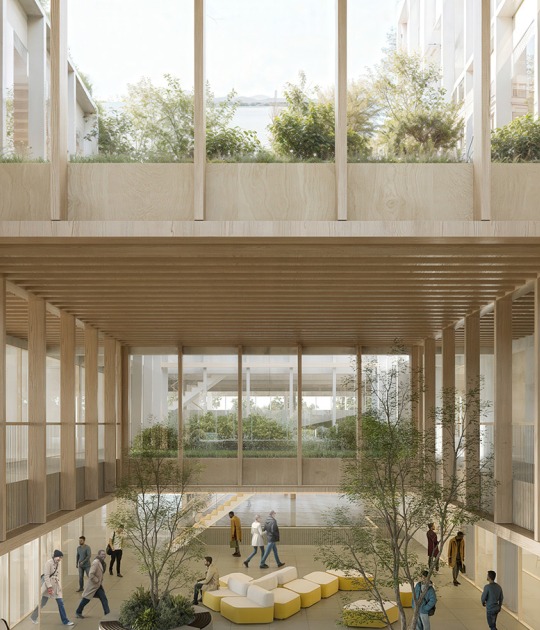Description of project by MVRDV and HASSEL+
The HASSELL+ team understands water designing for water, living with water and the immense social potential that waterfront places offer communities when they are connected to them. HASSELL, MVRDV, Deltares, Goudappel, Lotus Water, Civic Edge, Idyllist, Hatch, Page & Turnbull are drawn to Resilient by Design through an acute understanding of the social, cultural, economic and ecological potential that research-led design can unlock for waterfront communities.
In partnership with local experts - Lotus Water, Civic Edge, Page & Turnbull, Hatch and Idyllist - the team brings to this challenge a wealth of experience. Experience in researching, listening and engaging with communities, and designing, prototyping and delivering integrated solutions. The aim is to design and deliver places and systems that improve the physical and social resilience of communities while performing vital daily and emergency functions for those communities.
Revitalised public spaces that collect and connect people and water
For the collaborative research phase of the competition, HASSELL+ re-imagined a series of San Francisco waterfront communities as vibrant, fundamentally public places primed for everyday use – but also vital for environmental and emergency needs. Their response was inspired by the way the region’s communities used open spaces during both the 1906 San Francisco earthquake – one of the deadliest in US history – and the recent, devastating Northern California wildfires. HASSELL+ envisioned a network structure of green spaces, creeks and revived high streets that would serve as points of collection, connection and water management from the ridgeline to the shoreline and across the bay via an enhanced ferry network. Recharged ‘connectors’ – streets and creeks – and new ‘collectors’ – responsive, adaptable open spaces – would become places for everyday gathering, big events and disaster assembly. Together, they could ultimately make the Bay Area more physically and socially resilient.
Sites and programs co-designed with the local community
The team now has the opportunity to apply its ‘collect and connect’ toolkit to proposed sites in South San Francisco. At Colma Creek, HASSELL+ has imagined a new Shoreline Park. Meanwhile, Grand Avenue will become a vital community hub with a drop-in storefront people can visit during the design phase. The team’s design process will draw heavily on local voices and insights to ensure that design solutions – which will be presented in May – reflect the community’s needs. In addition to the drop-in centre, city
residents will be able to access a digital platform to learn about adapting for resilience and get involved in decision making.
Designing better waterfront cities – a range of international perspectives
Since the challenge launched last May, it’s received an outpouring of support from elected officials across all nine counties in the Bay Area. San Mateo County Board of Supervisors President Dave Pine sees it as an opportunity to draw on the technical expertise of design teams, think creatively, and ultimately, create lasting change in the county.
The team headed by HASSELL are one of ten teams selected by Resilient by Design, modelled after the successful Rebuild by Design challenge that addressed infrastructure needs in New York, New Jersey, and Connecticut following the devastation caused by Hurricane Sandy. The program is tied to The Rockefeller Foundation’s 100 Resilient Cities network, which aims to support 100 cities to build resilience for the 21st-century. The HASSELL+ team is an international team of experts who understands designing and living with water, alongside considering the potential that waterfront locations have for better connected and resilient communities.
HASSEL + (HASSELL, MVRDV, Deltares, Goudappel, Lotus Water, Civic Edge, Idyllist, Hatch, Page & Turnbull) is designing new initiatives in San Mateo County to avoid catastrophes derived from climate change.
The HASSEL+ team proposes the creation of collection points and connections from the center of the cities to the coastline. These connections work as streets for water withdrawal and water management in case of emergency.
More information
Published on:
January 30, 2018
Cite:
"Resilient by Design, by HASSELL+" METALOCUS.
Accessed
<https://www.metalocus.es/en/news/resilient-design-hassell>
ISSN 1139-6415
Loading content ...
Loading content ...
Loading content ...
Loading content ...
Loading content ...
Loading content ...
Loading content ...
Loading content ...
Loading content ...
Loading content ...
Loading content ...
Loading content ...
Loading content ...
Loading content ...
Loading content ...
Loading content ...
Loading content ...
Loading content ...
Loading content ...
Loading content ...
Loading content ...
Loading content ...
Loading content ...
Loading content ...
Loading content ...
Loading content ...
Loading content ...
Loading content ...
Loading content ...
Loading content ...
Loading content ...
Loading content ...
Loading content ...
Loading content ...
Loading content ...
Loading content ...
Loading content ...
Loading content ...
Loading content ...
Loading content ...
Loading content ...
Loading content ...
Loading content ...
Loading content ...
Loading content ...
Loading content ...
Loading content ...
Loading content ...
Loading content ...
Loading content ...
Loading content ...
Loading content ...
Loading content ...
Loading content ...



































